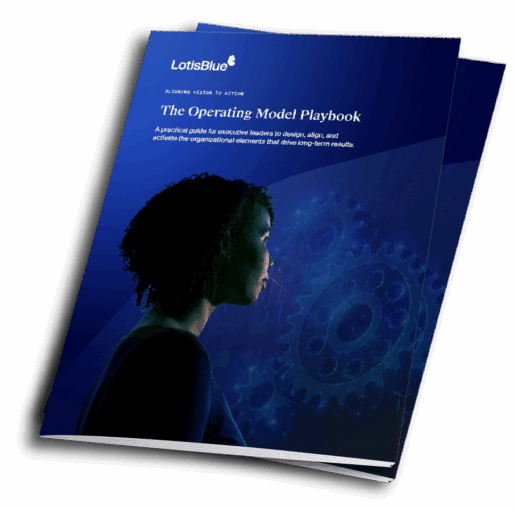Key Elements of Organization Design
Organization design is the process of defining and aligning seven critical elements: services and capabilities, organizing features, roles and accountabilities, decision rights and governance, structure, behavioral norms and culture, and workforce strategy. Identifying which of these elements are not working well together and realigning them with strategy and objectives yields improved business results. Success in organization design improves alignment, how people work together, and ultimately how effectively the organization delivers its products, solutions or services to customers.
Many companies attempt to create a new organization design by simply drawing new org charts in a vacuum without considering the ‘organizational wiring’ described above. This often results in the same actions and performance under new reporting lines. At Lotis Blue, we integrate a holistic design approach with specific sequencing to optimize organization design outcomes.
For optimal results, we collaborate to answer questions related to each of the seven organization design elements:
Services and Capabilities
Which services and capabilities create value for the business and its customers and deliver scale?
Organizing Features
What “blueprint” will be used to decide how work is organized and managed (e.g., centralized, decentralized, divisions or operating units)?
Roles and Accountabilities
Which leadership roles are critical to guide and execute work and what are the responsibilities and expected results to be delivered?
Decision Rights and Governance
What processes, forums, and guidelines for decision involvement will improve the speed and effectiveness of decision-making?
Structure
Which spans and layers should be added, removed, or strengthened to capture maximum value, enable better decisions, and create accountability?
Behavioral Norms and Culture
What changes are required to norms and cultural expectations for how people work and collaborate across the organization?
Workforce Strategy
What are the skills, locations, size, and labor model of the workforce needed to sustain a competitive advantage?
Lotis Blue's Approach to Organization Design
Crafting an organization design that meshes seamlessly with business strategy is not just beneficial—it’s crucial. It’s about creating a symbiotic relationship between strategy, organization, and talent to deliver results. The organization design and operating model should actively propel the strategic ambitions of the organization. This alignment ensures that every element of the organization, from its people to processes and technology, are geared toward the same goals. At Lotis Blue, our organization design consulting experience is grounded in the following observations and beliefs that support our clients.
It’s tempting to see everything as creating value, but doing so waters down the effort. Anchoring organization design decisions around existing talent, especially leaders, is suboptimal. While it may sound counterintuitive, organizations and the markets they serve, change much faster than people do. Organizations that successfully pivot do so by designing around the true drivers of business strategy and the capabilities that really provide a competitive advantage and are hard to replicate.
Every organization design choice should clearly support the end-business goals and align with agreed-upon design principles. These principles should be specific, measurable and not too broad. They should also be future-oriented, aspirational, closely tied to capabilities (not activities) and focus on differentiation rather than table stakes.
Leaders often kick off an organization design effort by redrawing boxes and lines, but this approach does little to improve results. Start with goals, capabilities, design principles, and customer requirements instead. Getting these elements right early on will prove much more important than reporting relationships. Long-term, the organization structure will serve as a management overlay to drive quality and accountability once the functional aspects of the design are in place.
“Who makes the decisions?” is a central question. Determining who makes specific decisions and who should be involved in the decision-making process is essential. Including too many people slows down decisions, makes it harder to be decisive, and can dilute the final outcome. Consulting too few people risks missing key facts or overlooking creative solutions. Much of the tension in poorly organized workplaces stems from overreliance on structure or escalating all decisions up the management hierarchy, rather than empowering those best equipped to make them.
There are always going to be fads in organization design, examples include: boundaryless, holacracy, matrix, the list goes on. However, this isn’t the place to follow fads or search for the “perfect” off-the-shelf structure. Every organization design option is a compromise based on the company’s differentiating capabilities, assets, current stage of growth, and organizational maturity. Designing the optimal organization requires wrestling with a number of trade-offs and considering whether current leaders and the culture will successfully embrace or reject the new ways of working that will follow.
Those most impacted by change, as well as key influencers, should be actively engaged from the beginning of the process to build alignment to the vision and business case for the new design. Bringing stakeholders together to agree on the business requirements, differentiating capabilities, and design principles is crucial. Achieving alignment here makes it easier to make decisions down the road about roles and accountabilities, structure, decision rights, and the organization chart. It also helps stakeholders begin to enroll their teams around the rationale for changes.
A Blueprint for Effective Organizational Design
The Operating Model Playbook outlines a three-phase approach to help executive leaders move from strategy to execution: clarify strategic intent, design the operating model, and embed it for lasting impact. It offers a practical, action-oriented guide to shaping an organization’s structure, roles, decision-making processes, workforce, and culture — turning bold objectives into real, measurable results. Grounded in proven frameworks and real-world experience, it equips leaders to cut through complexity and build organizations designed to perform.
Overcoming Challenges in Organization Design
Navigating the complexities of organization design demands a proactive and strategic approach to tackle the inherent challenges. Among these, resistance to change stands as a formidable barrier. To effectively address this resistance, it is critical to align people on the benefits of the planned destination point – the new organization. It is important to create a culture characterized by openness, transparency, and trust. This cultural shift paves the way for smoother transitions and improved collaboration that is crucial for the successful implementation of any new organization design.
At Lotis Blue, our organization design consulting practitioners have observed many companies that fail to use a methodology or a systematic approach to their organization design efforts. As a result, these companies often experience:
- Inefficient, time-wasting processes
- A lack of focus with people pulling in different directions
- Capabilities diffused across teams or buried deep in organizational layers
- Managerial bloat
- Too much firefighting and just-in-time management
- Poor collaboration, leading to turf battles and blame wars
- Slow decision-making
- Inability to mobilize the right resources for the right work
- Poor information exchange — top to bottom or between departments
- High performers stretched too thin
- Narrow and uninteresting jobs, leading to high employee turnover
These problems are not embedded in a company’s DNA; they arise over time as businesses outgrow their early organization design or when faced with new realities in the marketplace, such as new competition, changes in customer behavior, or a disruptive business model. By tackling these obstacles head-on with a strategic and systematic approach, leaders can unlock the transformative potential of designing the right organization to execute the company’s unique strategy.
Common Questions About Organization Design
Lotis Blue views organization design as more than just restructuring charts. Our approach aligns business strategy with organizational structure by clarifying how people collaborate, how decisions are made, and how work gets one to deliver sustained performance. Our evidence-based strategies combine analytics and behavioral science to drive meaningful business performance and accelerate growth.
Lotis Blue bridges the gap between strategic intent and day-to-day execution. We translate business strategy into clear roles, decision rights, and workflows, ensuring structure, leadership, and talent systems are aligned to deliver results. Our evidence-based methods help organizations not only define where they’re going but build the capabilities and operating rhythm to get there.
Lotis Blue combines deep expertise in operating model transformation with behavioral and data science insights. This integration enables us to design organizations that are both analytically sound and human-centered. Our consultants work alongside leaders to ensure the design decisions are practical, sustainable, and directly linked to business outcomes, not just organizational charts.
Sustainable design requires alignment between structure, leadership behavior, and culture. Lotis Blue applies proven change acceleration methods—rooted in behavioral science—to help leaders embed new ways of working and sustain momentum. We equip teams with tools and data to monitor progress, ensuring the new design delivers measurable performance improvement over time.
Not at Lotis Blue. While thoughtful design can uncover efficiencies, our focus is on aligning structure, talent, and decision-making to strategy, not reducing headcount. We help organizations reallocate resources toward growth, agility, and innovation. By clarifying roles and simplifying decision rights, our designs accelerate decision-making and execution, resulting in faster, more effective performance rather than one-time cost savings.
Make Bold Moves
Thank you for your interest in Lotis Blue. Please fill out the form to let us
know how we can help. We’ll be in touch soon.










